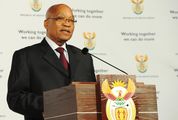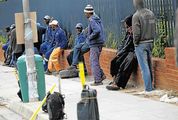BOOK REVIEW: Gurkha
by Aron Human,
2015-11-02 20:13:20.0
GURKHA is a well-written military account of the type of warfare a modern military would be engaged in while trying to grapple with an ever-evolving guerrilla army such as the Taliban. Even so, one can’t help but feel that the book carries with it a tinge of propaganda.
Colour Sergeant Kailash Limbu, from Second Battalion The Royal Gurkha Rifles, was selected by the brigade headquarters to be the first serving Gurkha soldier to tell his story. The Gurkhas have been part of the British Army for 200 years, and you get the feeling that the Queen herself sanctions the Nepalese fighter to speak. "For the first time in its two-hundred-year history, a soldier of the Brigade of Gurkhas has been given permission to tell his story in his own words," states the back cover blurb.
Strangely, this relationship between the UK and Nepal came about when the Nepalese were conquered by the Brits, and, as a consolation prize for putting up a valiant effort against a vastly superior invading force, they were allowed to serve the British throne and to protect the people of Britain from whoever is the latest enemy that needs a good beating. I think there is a name for this … oh yes, Stockholm syndrome.
Limbu tells the story of the summer of 2006, when British Army Gurkhas fought one of the longest, fiercest sieges of Britain’s Afghanistan conflict. The author and his squad find their well-defended compound under attack. A lot of people get shot and blown up.
Limbu takes time to explain that the British army was in Afghanistan to help the Afghans and that he feels no remorse for having killed a man, and would gladly shoot him again. "They were very good fighters and they were brave men, but I didn’t have any regrets about trying to shoot them because they were first trying to kill us."
The book might be an honest account but it is hard to neglect the disturbing effect that it has on the reader. The forces engaged in the coalition against terror are finding it harder than ever to justify whatever it is they have been doing in Asia for so many years.
Just as the British have written the narratives of many colonised nations, this book unwittingly does so again. It sells the idea that the men and women fighting in Iraq and Afghanistan are not only white, but that there is a united global effort to deal with people the West does not like anymore.
There is never a doubt from the colour sergeant’s account that their position was in any serious danger of being overrun. Nor was it clear exactly what they were trying to achieve, although Limbu assures himself and the reader over and over again that they are there to help the people of Afghanistan.
The people of the small rural Afghan village of Now Zad are dehumanised throughout the book. Normally this would raise alarms in most readers’ heads but since the author states the similarities between himself and the Afghans at the start of the book, it’s fair game from there on.
It’s a dirty trick that imperialists have used before in Africa when the Belgians perpetuated myths about the difference in superiority between the Hutus and Tutsis in Rwanda. It is a weapon difficult to identify and almost impossible to fight against without prior awareness of its effectiveness.
The jolly old brown chaps from the Himalayas have no problem fighting in the British armed forces and, from the author’s account, there can be no higher honour than killing other brown chaps in the desert of Afghanistan, chaps whom the author laments look remarkably similar to themselves. They even speak a similar language.

Picture: THINKSTOCK
GURKHA is a well-written military account of the type of warfare a modern military would be engaged in while trying to grapple with an ever-evolving guerrilla army such as the Taliban. Even so, one can’t help but feel that the book carries with it a tinge of propaganda.
Colour Sergeant Kailash Limbu, from Second Battalion The Royal Gurkha Rifles, was selected by the brigade headquarters to be the first serving Gurkha soldier to tell his story. The Gurkhas have been part of the British Army for 200 years, and you get the feeling that the Queen herself sanctions the Nepalese fighter to speak. "For the first time in its two-hundred-year history, a soldier of the Brigade of Gurkhas has been given permission to tell his story in his own words," states the back cover blurb.
Strangely, this relationship between the UK and Nepal came about when the Nepalese were conquered by the Brits, and, as a consolation prize for putting up a valiant effort against a vastly superior invading force, they were allowed to serve the British throne and to protect the people of Britain from whoever is the latest enemy that needs a good beating. I think there is a name for this … oh yes, Stockholm syndrome.
Limbu tells the story of the summer of 2006, when British Army Gurkhas fought one of the longest, fiercest sieges of Britain’s Afghanistan conflict. The author and his squad find their well-defended compound under attack. A lot of people get shot and blown up.
Limbu takes time to explain that the British army was in Afghanistan to help the Afghans and that he feels no remorse for having killed a man, and would gladly shoot him again. "They were very good fighters and they were brave men, but I didn’t have any regrets about trying to shoot them because they were first trying to kill us."
The book might be an honest account but it is hard to neglect the disturbing effect that it has on the reader. The forces engaged in the coalition against terror are finding it harder than ever to justify whatever it is they have been doing in Asia for so many years.
Just as the British have written the narratives of many colonised nations, this book unwittingly does so again. It sells the idea that the men and women fighting in Iraq and Afghanistan are not only white, but that there is a united global effort to deal with people the West does not like anymore.
There is never a doubt from the colour sergeant’s account that their position was in any serious danger of being overrun. Nor was it clear exactly what they were trying to achieve, although Limbu assures himself and the reader over and over again that they are there to help the people of Afghanistan.
The people of the small rural Afghan village of Now Zad are dehumanised throughout the book. Normally this would raise alarms in most readers’ heads but since the author states the similarities between himself and the Afghans at the start of the book, it’s fair game from there on.
It’s a dirty trick that imperialists have used before in Africa when the Belgians perpetuated myths about the difference in superiority between the Hutus and Tutsis in Rwanda. It is a weapon difficult to identify and almost impossible to fight against without prior awareness of its effectiveness.
The jolly old brown chaps from the Himalayas have no problem fighting in the British armed forces and, from the author’s account, there can be no higher honour than killing other brown chaps in the desert of Afghanistan, chaps whom the author laments look remarkably similar to themselves. They even speak a similar language.





















Change: -2.70%
Change: -2.83%
Change: -4.03%
Change: -2.13%
Change: -3.99%
Data supplied by Profile Data
Change: -2.53%
Change: -1.47%
Change: -2.70%
Change: 0.00%
Change: -1.31%
Data supplied by Profile Data
Change: 1.41%
Change: 0.86%
Change: 1.84%
Change: 2.02%
Change: 0.68%
Data supplied by Profile Data
Change: 0.18%
Change: -1.05%
Change: -0.14%
Change: -2.30%
Change: -2.97%
Data supplied by Profile Data